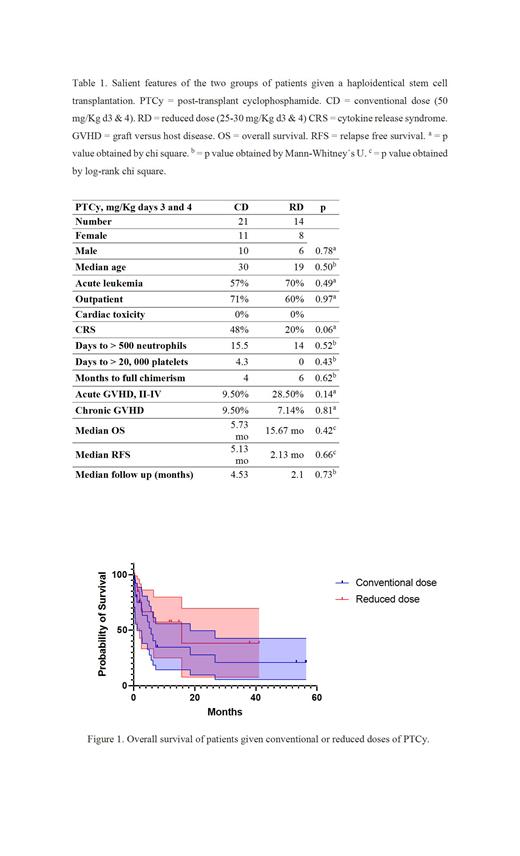Background
Allogeneic hematopoietic cell transplantation (HSCT) remains the most important curative modality for several hematologic malignancies, but an HLA-matched sibling or unrelated donor is not always available, particularly for ethnic minorities and multiethnic families. Haploidentical HSCT (Haplo-HSCT) is a solution and, since it can be safely conducted on an outpatient basis, the costs can be substantially reduced; toxicity, however, remains a major problem.
Material and methods
All patients given a Haplo-HSCT in the Centro de Hematología y Medicina Interna in Puebla, México and Hospital Universitario de Nuevo León, Nuevo León, México employing the “Mexican” method to conduct Haplo-HSCT on an outpatient basis were included. The employed protocol is as follows: Fludarabine dose of 50 mg/m2 IV daily from Day -6 to Day -4 (total dose received 150 mg/m2), Pre-HSCT Cyclophosphamide dose of 500mg/m2 IV daily from Day -7 to Day -4 (total dose received 2000 mg/m2). Post-HSCT Cyclophosphamide daily from Days +3 to +4, conventional dose: 50 mg/kg IV; reduced dose 25-30mg/kg IV. The employed protocol is registered in www.clinicalTrials.gov, identifier NCT05780554. Between March 2013 and July 2016, the transplants were done using the conventional doses (CD) of PTCy (50 mg/Kg) on d 3 and 4, whereas after July 2016, the allografts were done using reduced doses (RD-PTCy) 25-30 mg/Kg, d 3 and 4. Twenty-one patients received the CD, whereas 14 were given RD. All grafts were started as outpatients and could be completed as outpatients in 71% and 60% of cases respectively, for the groups of CD and RD.
Results
According to the statistical analysis, the two comparative groups (CD-PTCy versus RD-PTCy) had no significant differences in terms of age, sex and hematological recovery. Cytokine release syndrome and hematological toxicity were less frequent in the group of persons given RD-PTCy, whereas the prevalence of both acute and chronic graft versus host disease was similar in the two groups (Table 1). The median OS for the group CD-PTCy is 5.7 months meanwhile for the RD-PTCy is 15.67 months. The figure 1 depicts the Kaplan-Meier OS plots for the two subsets of patients, which were not statistically different. The RFS were better in the patients grafted with RD-PTCy (2.13 mo vs 5.13 mo). There are no differences between PTCy 25mg/kg and 30mg/kg. The median follow up for entire group is 4.53 months (IQR: 1.1 - 18.9 mo).
Conclusion
These results indicate that the doses of PTCy can be significantly reduced without compromising the effectiveness of the Haplo-HSCT conducted in an outpatient basis and employing the “Mexican” reduced intensity method. This preliminary observation may be considered as an idea to conduct prospective randomized studies to explore the possibility of significantly reducing the doses of PTCy in the setting of Haplo-HSCT.
Disclosures
Gomez-De Leon:Abbvie: Honoraria; Novartis: Honoraria; Astellas: Honoraria; AMGEN: Honoraria; Jnssen: Other: Advisory board; Sanofi: Honoraria. Gomez-Almaguer:AMGEN: Consultancy, Honoraria; Janssen: Consultancy, Honoraria; Novartis: Honoraria; AbbVie: Consultancy, Honoraria.


This feature is available to Subscribers Only
Sign In or Create an Account Close Modal